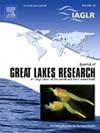Food web structure of the Lake Superior fish community in 2021–2022
IF 2.5
3区 环境科学与生态学
Q3 ENVIRONMENTAL SCIENCES
引用次数: 0
Abstract
The trophic linkages and ecological requirements of the Lake Superior fish community have not been assessed on a whole lake scale in over a decade. Here, we investigated the trophic dynamics across multiple species and habitat zones of Lake Superior. From April to October of 2021 and 2022, a total of five piscivore, four planktivore, and six benthivore species were collected by region and length class during bottom-trawl, standard gillnet, commercial cisco gillnet, and recreational angler surveys. To assess trophic linkages, stomach contents were measured to estimate biomass consumed and a multivariate analysis was used to assess diet composition by species, length, and region. We found a high degree of interconnectedness in the Lake Superior food web, with Mysis as a critical diet item for most fishes. Native piscivore diets varied by region and with ontogeny. Lake charr were important habitat couplers in the lake, exhibiting a diverse diet and opportunistic foraging strategy. Conversely, Pacific salmon were more restricted in their foraging. Planktivores and benthivores primarily consumed Mysis, with less reliance on Diporeia compared to previous studies. Lake whitefish and cisco were the exception to this pattern, with broader bathymetric depth distributions represented in their diets. We found the food web to be supported by a predominantly native species assemblage, with redundancies at all trophic levels.
2021-2022年苏必利尔湖鱼类群落食物网结构
苏必利尔湖鱼类群落的营养联系和生态需求十多年来一直没有在整个湖泊尺度上进行评估。本文研究了苏必利尔湖不同物种和生境带的营养动态。在2021年和2022年的4 - 10月,通过底拖网、标准刺网、商用cisco刺网和休闲垂钓者调查,按区域和长度分类,共采集到5种鱼栖动物、4种浮游动物和6种底栖动物。为了评估营养联系,研究人员测量了胃内容物以估计消耗的生物量,并使用多变量分析来评估按物种、长度和地区划分的饮食组成。我们在苏必利尔湖的食物网中发现了高度的相互联系,其中蜜丝是大多数鱼类的关键饮食项目。本地鱼鱼的饮食因地区和个体发育而异。湖鲑是湖中重要的栖息地耦合器,表现出多样化的饮食和机会主义的觅食策略。相反,太平洋鲑鱼在觅食方面受到更多限制。浮游动物和底栖动物主要消耗myysis,与之前的研究相比,对Diporeia的依赖较少。湖白鱼和cisco是这种模式的例外,它们的饮食具有更广泛的水深分布。我们发现食物网主要由本地物种组合支持,在所有营养水平上都有冗余。
本文章由计算机程序翻译,如有差异,请以英文原文为准。
求助全文
约1分钟内获得全文
求助全文
来源期刊

Journal of Great Lakes Research
生物-海洋与淡水生物学
CiteScore
5.10
自引率
13.60%
发文量
178
审稿时长
6 months
期刊介绍:
Published six times per year, the Journal of Great Lakes Research is multidisciplinary in its coverage, publishing manuscripts on a wide range of theoretical and applied topics in the natural science fields of biology, chemistry, physics, geology, as well as social sciences of the large lakes of the world and their watersheds. Large lakes generally are considered as those lakes which have a mean surface area of >500 km2 (see Herdendorf, C.E. 1982. Large lakes of the world. J. Great Lakes Res. 8:379-412, for examples), although smaller lakes may be considered, especially if they are very deep. We also welcome contributions on saline lakes and research on estuarine waters where the results have application to large lakes.
 求助内容:
求助内容: 应助结果提醒方式:
应助结果提醒方式:


